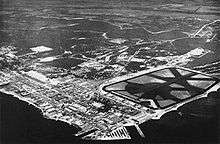Chevalier Field

Chevalier Field was the original non-seaplane aircraft landing area at Naval Air Station Pensacola, Florida. Established originally in 1922 as Station Field, it was an expansion of the balloon operating field that opened in 1916. It was located on the northeast side of the Navy shipyard, on the western edge of Pensacola Bay and south of Bayou Grande. The small town of Woolsey, just north of the Navy Yard, had been razed for the creation of the airdrome. [1] "Locals assumed the Army's involvement in the project and had to be informed that the field, initially called Station Field, was intended for the exclusive use of Navy landplanes."[2]
Expanded in 1935, it was renamed Chevalier Field on 30 December 1936 [3] for Lt. Cdr. Godfrey DeCourcelles Chevalier, a graduate of the U.S. Naval Academy in June 1910, who was appointed Naval Air Pilot No. 7 on 7 November 1915 and a Naval Aviator No. 7 on 7 November 1918. Chevalier commanded the first naval air station in France, at Dunkerque, in November 1917, and for his World War I service was awarded the Navy Distinguished Service Medal. On 26 October 1922 Lieutenant Commander Chevalier made the first landing on the USS Langley's deck, the U.S. Navy's first aircraft carrier, in an Aeromarine 39-B, A-606. Chevalier died at the Portsmouth Naval Hospital 14 November 1922 as a result of injuries sustained in the crash of a Vought VE-7 on 12 November while flying from NAS Norfolk to Yorktown, Virginia.[4][5]
A blimp hangar and two aircraft hangars had been constructed on the south side of the field by 1935, and the field was further expanded in 1938, adding schools for aviation medicine and aviation maintenance. By World War II, the field had seven asphalt runways arranged in two clusters that intersected in mid-field, the longest 3,100 feet. Seaplane hangars had been added on the southeast corner facing Pensacola Bay by this time.[6]
With the introduction of jet aircraft, Chevalier's limited runway space became a problem, and on 2 November 1951, Forrest Sherman Field was dedicated,[7] three miles to the west, which remains the primary air facility at NAS Pensacola, as well as the home of the Blue Angels demonstration team. Chevalier Field remained in limited use as a helicopter facility and its perimeter was used as a storage area for aircraft awaiting refurbishment by the Naval Air Rework Facility (NARF) located at the base into the 1980s. A rail spur onto the navy base was aligned along the western edge of the airfield until it was removed circa 1979. This line was originally the Pensacola and Fort Barrancas Railroad, dating from 1870, an eight-mile line connecting Pensacola with Fort Barrancas through Warrington and Woolsey. [8]
Helicopter operations apparently ended in the period 1994-1996, although the airfield itself was closed by 1976.[9] In the late 1990s, the airfield was completely removed as a new complex of buildings and barracks for the Naval Air Technical Training Center was erected on the site. Several hangar buildings, including the control tower, still exist and have been adapted for reuse as part of the NATTC facility.[10]
References
- ↑ http://www.airfields-freeman.com/FL/Airfields_FL_Pensacola_SW.htm#chevalier
- ↑ Shettle, Jr., M. L., "United States Naval Air Stations of World War II, Volume I: Eastern States", Schaertel Publishing Co., Bowersville, Georgia, 1995, Library of Congress card number 94-68879, ISBN 0-9643388-0-7, page 177.
- ↑ http://www.history.navy.mil/download/history/app11.pdf
- ↑ Linder, Bruce, "Tidewater's Navy", Naval Institute Press, Annapolis, Maryland, Library of Congress card number 2005019790, ISBN 1-59114-465-5, page 154.
- ↑ http://www.history.navy.mil/danfs/c7/chevalier-ii.htm
- ↑ http://www.airfields-freeman.com/FL/Airfields_FL_Pensacola_SW.htm#chevalier
- ↑ http://www.pnj.com/article/99999999/NEWS12/110216005/100-Years-Naval-Aviation-100-historical-facts?nclick_check=1
- ↑ Turner, Gregg M., "A Journey Into Florida Railroad History", University Press of Florida, Library of Congress card number 2007050375, ISBN 978-0-8130-3233-7, page 94.
- ↑ http://www.airfields-freeman.com/FL/Airfields_FL_Pensacola_SW.htm#chevalier
- ↑ http://www.airfields-freeman.com/FL/Airfields_FL_Pensacola_SW.htm#chevalier
Coordinates: 30°21′13″N 87°16′05″W / 30.35361°N 87.26806°W